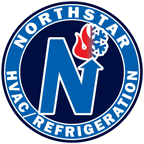What Business Owners Need to Know About A2L Refrigerants
Written by Ed Rice
The HVAC and refrigeration industry is undergoing a major transition with the phase-down of high-global warming potential (GWP) refrigerants. In 2025, new regulations will require businesses to shift towards A2L refrigerants, a new class of low-GWP, mildly flammable refrigerants designed to comply with environmental standards while maintaining energy efficiency.
For business owners, understanding what A2L refrigerants are, how they affect your HVAC and refrigeration systems, and what steps you need to take for compliance is critical. In this blog post, we’ll break down everything you need to know about A2L refrigerants and how to prepare for this industry shift.
What Are A2L Refrigerants?
A2L refrigerants are a classification of low-GWP refrigerants that offer improved environmental performance compared to traditional hydrofluorocarbons (HFCs) like R-410A and R-134a. The “A” rating means they have low toxicity, and the “2L” rating signifies that they are mildly flammable (less flammable than A3 refrigerants like propane but requiring special handling considerations).
Common A2L refrigerants include:
R-32 – Used in residential and light commercial air conditioning.
R-454B – A replacement for R-410A in commercial HVAC systems.
R-1234yf and R-1234ze – Used in automotive and industrial refrigeration.
These refrigerants are being adopted due to their significantly lower global warming potential (GWP) compared to their predecessors, helping businesses meet environmental regulations while maintaining operational efficiency.
Why Is the Industry Transitioning to A2L Refrigerants?
The shift to A2L refrigerants is driven by government regulations aimed at reducing greenhouse gas emissions. These changes stem from:
The AIM Act & HFC Phase-Down
The American Innovation and Manufacturing (AIM) Act mandates a 40% reduction in HFC production by 2024, with further reductions leading to an 85% phase-down by 2036. This means that older refrigerants like R-410A and R-134a will become increasingly scarce and expensive as they are phased out.
Compliance with the Kigali Amendment
The Kigali Amendment to the Montreal Protocol is a global agreement aimed at reducing the use of high-GWP refrigerants. The U.S. has committed to following these standards, further accelerating the need for low-GWP alternatives like A2Ls.
Improved Energy Efficiency
Many A2L refrigerants offer improved thermal performance, leading to greater energy efficiency and lower operating costs for businesses. Systems designed for A2Ls often consume less power, reducing long-term energy bills.
How Will A2L Refrigerants Impact Your Business?
If your business relies on HVAC or refrigeration systems, the transition to A2Ls will impact installation, maintenance, and compliance. Here’s what you need to know:
New Equipment Requirements
Most existing HVAC systems cannot be retrofitted to use A2L refrigerants. This means that when replacing an old unit, businesses will need to invest in A2L-compatible equipment.
Manufacturers are already producing new chillers, heat pumps, and refrigeration units designed for A2Ls.
Safety Considerations
While A2L refrigerants are mildly flammable, they require specialized training and handling procedures. HVAC technicians will need certification and updated safety protocols when working with these refrigerants.
Proper ventilation and leak detection systems may be required in some commercial or industrial settings using A2Ls.
Regulatory Compliance
Businesses will need to update refrigerant tracking logs to ensure they are using EPA-compliant refrigerants.
Certain industries, such as cold storage, food processing, and pharmaceuticals, may face additional safety and compliance requirements when transitioning to A2Ls.
Cost Considerations
The upfront cost of new A2L-compatible equipment may be higher than traditional units, but the long-term savings on energy bills and regulatory compliance will offset this.
Incentives and rebates for energy-efficient HVAC upgrades may be available through programs like Mass Save and federal tax credits.
How to Prepare for the Transition to A2L Refrigerants
Assess Your Current Systems
Identify which HVAC and refrigeration systems in your facility use high-GWP refrigerants like R-410A or R-134a.
Work with an HVAC professional to determine the best strategy for upgrading equipment.
Plan for Equipment Upgrades
If your system is nearing end-of-life, consider replacing it with an A2L-compatible unit to stay ahead of the transition.
When purchasing new equipment, confirm that it is designed for low-GWP refrigerants to ensure long-term compliance.
Train Your Maintenance Team
Ensure that technicians and facility managers are educated on the safe handling and maintenance of A2L refrigerants.
Work with HVAC partners who have experience installing and servicing A2L-compatible systems.
Take Advantage of Incentives
Look for rebates and tax credits for upgrading to energy-efficient A2L systems.
Contact local utility programs to explore available financial incentives.
How Northstar Refrigeration Can Help
At Northstar Refrigeration, we’re committed to helping businesses transition smoothly to A2L refrigerants while maximizing energy efficiency and compliance. Our team offers:
Refrigerant Transition Planning – Evaluate your current systems and recommend the best upgrade options.
A2L-Compatible HVAC & Refrigeration Solutions – Expert installation of energy-efficient systems.
Safety & Compliance Training – Ensuring your team is prepared for new refrigerant regulations.
Incentive & Rebate Assistance – Helping you offset costs with available programs.
Final Thoughts
The transition to A2L refrigerants is one of the most significant changes in the HVAC and refrigeration industry in recent years. As high-GWP refrigerants are phased out, businesses must prepare by investing in new equipment, training staff, and ensuring compliance with evolving regulations.
By planning ahead, you can avoid supply shortages, minimize costs, and position your business for long-term success in a greener, more efficient HVAC landscape.
Need expert guidance? Contact Northstar Refrigeration at (508) 888-3692 to discuss how we can help you navigate the shift to A2L refrigerants and ensure your facility is ready for 2025 and beyond.
(508) 888-3692
www.northstarhvacr.com


